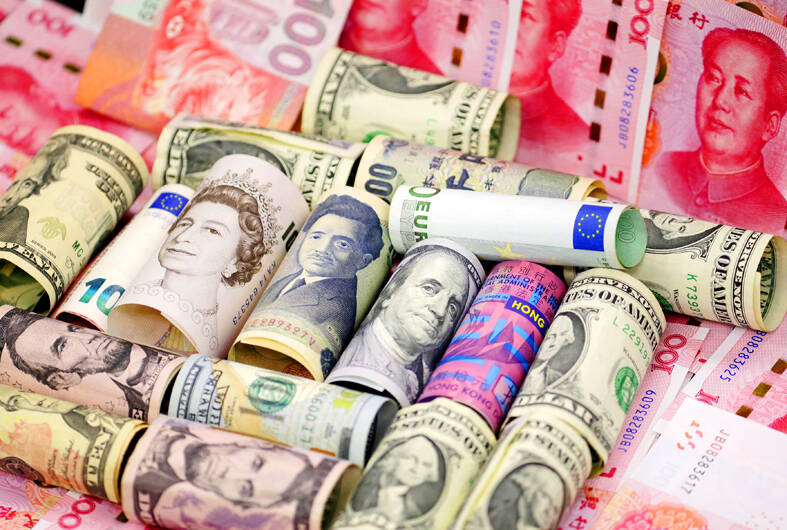Taiwan’s foreign exchange reserves last month fell by US$118 million to US$569.42 billion, dragged by depreciations in major reserve currencies against the US dollar and an intervention to shore up the local currency, the central bank said yesterday.
The monthly retreat ran counter to TAIEX rallies on the back of global fund inflows to take advantage of excitement over artificial intelligence.
“The divergent showings in the local bourse and New Taiwan dollar are not abnormal, but moved in sync with a strong greenback and Wall Street,” Department of Foreign Exchange Director-General Eugene Tsai (蔡炯民) said.

Photo: Reuters
The NT dollar and the TAIEX have displayed trajectories closely linked to the US dollar and major US tech shares, Tsai said.
The US dollar last month gained 0.85 percent, while the NT dollar softened 0.87 percent, the yen fell 1.39 percent, the yuan dropped 0.26 percent and the Australian dollar fell 0.82 percent, he said.
At the same time, heavyweight tech shares in Taiwan hit fresh highs, taking cues from rallies in US semiconductor and technology shares, he added.
Global fund inflows last month totaled US$5.08 billion according to the Financial Supervisory Commission’s measure and about US$3 billion according to the central bank, after including profit remittances abroad, Tsai said.
Foreign institutional players raised holdings in local shares mainly via currency swap operations and cash dividends from local tech firms, which do not boost the local currency, he said.
The US dollar’s uptrend came after healthy US economic data dashed hopes that the US Federal Reserve would cut interest rates as early as this month and as many as six times this year, Tsai said.
Taiwan remained the world’s fourth-largest holder of foreign exchange reserves after China, Japan and Switzerland, he said.

TARIFF TRADE-OFF: Machinery exports to China dropped after Beijing ended its tariff reductions in June, while potential new tariffs fueled ‘front-loaded’ orders to the US The nation’s machinery exports to the US amounted to US$7.19 billion last year, surpassing the US$6.86 billion to China to become the largest export destination for the local machinery industry, the Taiwan Association of Machinery Industry (TAMI, 台灣機械公會) said in a report on Jan. 10. It came as some manufacturers brought forward or “front-loaded” US-bound shipments as required by customers ahead of potential tariffs imposed by the new US administration, the association said. During his campaign, US president-elect Donald Trump threatened tariffs of as high as 60 percent on Chinese goods and 10 percent to 20 percent on imports from other countries.

Taiwanese manufacturers have a chance to play a key role in the humanoid robot supply chain, Tongtai Machine and Tool Co (東台精機) chairman Yen Jui-hsiung (嚴瑞雄) said yesterday. That is because Taiwanese companies are capable of making key parts needed for humanoid robots to move, such as harmonic drives and planetary gearboxes, Yen said. This ability to produce these key elements could help Taiwanese manufacturers “become part of the US supply chain,” he added. Yen made the remarks a day after Nvidia Corp cofounder and chief executive officer Jensen Huang (黃仁勳) said his company and Taiwan Semiconductor Manufacturing Co (TSMC, 台積電) are jointly

United Microelectronics Corp (UMC, 聯電) expects its addressable market to grow by a low single-digit percentage this year, lower than the overall foundry industry’s 15 percent expansion and the global semiconductor industry’s 10 percent growth, the contract chipmaker said yesterday after reporting the worst profit in four-and-a-half years in the fourth quarter of last year. Growth would be fueled by demand for artificial intelligence (AI) servers, a moderate recovery in consumer electronics and an increase in semiconductor content, UMC said. “UMC’s goal is to outgrow our addressable market while maintaining our structural profitability,” UMC copresident Jason Wang (王石) told an online earnings

MARKET SHIFTS: Exports to the US soared more than 120 percent to almost one quarter, while ASEAN has steadily increased to 18.5 percent on rising tech sales The proportion of Taiwan’s exports directed to China, including Hong Kong, declined by more than 12 percentage points last year compared with its peak in 2020, the Ministry of Finance said on Thursday last week. The decrease reflects the ongoing restructuring of global supply chains, driven by escalating trade tensions between Beijing and Washington. Data compiled by the ministry showed China and Hong Kong accounted for 31.7 percent of Taiwan’s total outbound sales last year, a drop of 12.2 percentage points from a high of 43.9 percent in 2020. In addition to increasing trade conflicts between China and the US, the ministry said